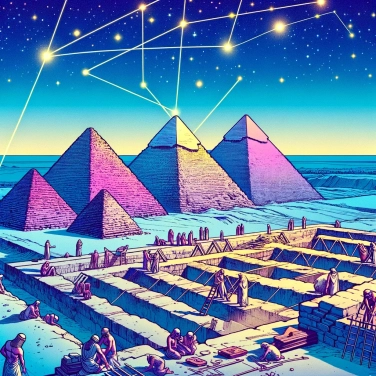The pyramids of Egypt are aligned with such precision due to the use of simple yet effective instruments like the astrolabe and stars to point towards the cardinal directions, as well as sophisticated leveling techniques using rudimentary bubble levels.

The ancient Egyptians mastered the art of fitting enormous stone blocks together without mortar. Their secret: perfectly leveled foundations and an ultra-precise arrangement of the blocks. They used ramps to raise the monumental stones and simple yet effective lever systems to position them accurately. Their ability to manage the physical constraints of materials, combined with their intuitive understanding of structural stability, allowed them to build pyramids capable of defying time. This is particularly astonishing when considering the few tools these guys had at their disposal, often no more than a rope, a rudimentary level, and their craftsmanship.
The ancient Egyptians closely observed the sky, which allowed them to precisely align their pyramids with certain celestial bodies, notably the stars. The most famous example is the pyramids of the Giza plateau: they almost perfectly follow the alignment of Orion's belt, a group of three stars that is very visible to the naked eye and very important in Egyptian mythology. Similarly, the faces of the Great Pyramid are oriented almost exactly towards the cardinal points, with impressive precision considering the tools of the time. This astronomical obsession likely served both practical purposes, such as indicating the seasons for agriculture, and spiritual ones, symbolically linking royal tombs to the eternity of the stars.
The Egyptians primarily used the knot rope, a basic yet highly effective tool. They stretched this graduated rope to mark precise right angles, thanks to the famous Pythagorean theorem (which they knew in a practical form without having theorized the equation). To determine the north-south orientation accurately, the builders carefully observed the stars, especially by following the North Star or by noting the rise and set of certain key stars. The sun itself acted as a kind of large clock, with shadows specifically studied to indicate directions and precise angles. Finally, the accuracy of horizontal levels was ensured using simple tools like water trenches serving as a water level. Simple, rudimentary, but brilliantly effective.
The Egyptian pyramids are not just grand tombs: they also reflect the cosmic vision of the ancient Egyptians. Building precisely oriented towards the stars is to recreate a piece of the sky on Earth. According to their beliefs, the soul of the pharaoh ascends directly to specific stars, mainly those in the constellation of Orion, symbolizing resurrection and eternity. This hyper-precise alignment was meant to facilitate the spiritual journey of the deceased to the afterlife, ensuring their eternal life among the gods.
Originally, the pyramids were covered with polished white limestone, which reflected sunlight and made them visible from several kilometers away; they appeared as radiant monuments resembling terrestrial stars.
Ancient Egyptians used simple yet clever methods, such as observing the shadow cast by a stick (gnomon) or using rudimentary tools like the merkhet, to achieve astronomical alignments and orientations with exceptional precision.
Some theories suggest that the positions and arrangement of the three pyramids of Giza reflect the layout of the Orion constellation, particularly the stars of Orion's belt: a theory known as the Orion Correlation Theory.
The Egyptian builders had neither hard metal nor advanced wheels when constructing the pyramids. Despite these technological limitations, they developed ingenious techniques to move and precisely position stone blocks weighing several tons.
Despite their impressive accuracy, very slight deviations in orientation (a few fractions of a degree) can sometimes be observed in certain pyramids, likely due to minor variations in the astronomical methods used and the ancient measuring instruments.
The Egyptians believed in a deep spiritual connection between the pharaohs and the celestial gods. This precise stellar alignment symbolized cosmic harmony and, according to their beliefs, ensured a successful ascent of the deceased to the heavens.
Among the known tools are the use of the gnomon to measure solar shadows, the knotted cord serving as a mathematical instrument for drawing precise angles, and the merkhet, an astronomical instrument dedicated to nighttime observation of stars to determine axes and alignments.
Although the majority of the great pyramids are aligned along precise north-south and east-west axes, some Egyptian constructions exhibit variations in their alignments, likely due to evolving cult practices and cultural factors or specific geographical constraints.
The ancient Egyptians primarily used the observation of circumpolar stars, especially the star Thuban (in the constellation Draco), to accurately determine the north-south axis and thereby orient the pyramids with remarkable precision.

70% of respondents passed this quiz completely!
Question 1/4